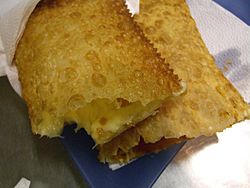Pastel (Brazilian food) facts for kids

Cheese pastel made in São Paulo
|
A pastel (pronounced pah-STEL) is a super popular fast-food snack from Brazil. It's like a thin, crispy pie, often shaped like a half-circle or rectangle. These tasty treats are filled with all sorts of yummy ingredients and then fried until they're golden brown.
Pastéis are known for their crunchy outside and warm, flavorful inside. You can find them with many different fillings. Some popular savory ones include ground meat, gooey mozzarella cheese, creamy catupiry cheese, heart of palm, chicken, and even small shrimp. If you have a sweet tooth, you might find pastéis filled with guava paste and Minas cheese, banana, or chocolate.
In Brazil, a pastel is called a salgado, which means a savory snack. You'll often see them sold by street vendors, at lively outdoor markets, or in special fast-food shops called pastelarias. A common drink to enjoy with a pastel is caldo de cana, which is fresh sugarcane juice.
Contents
What is a Brazilian Pastel?
A pastel is a fried pastry that's a big part of Brazilian cuisine. Imagine a thin dough, almost like a wrapper, folded over a delicious filling and then deep-fried. This cooking method makes the pastel wonderfully crispy and a bit bubbly on the outside.
Common Fillings
Pastéis come with a huge variety of fillings, so there's usually something for everyone!
- Savory options:
* Meat: Often seasoned ground meat. * Cheeses: Mozzarella, catupiry (a creamy Brazilian cheese), or cream cheese. * Vegetables: Heart of palm is a unique and popular choice. * Seafood: Small shrimp or codfish are also used. * Chicken: Shredded and seasoned chicken is a favorite.
- Sweet options:
* Guava and Cheese: A classic mix of sweet guava paste with Minas cheese. * Fruits: Banana is often used, sometimes with cinnamon. * Chocolate: A simple, sweet treat.
Where to Find Pastéis
Pastéis are a common sight in Brazil. You can buy them in several places:
- Street Markets: Many cities have open-air markets where vendors fry pastéis fresh on the spot.
- Street Vendors: You might see small carts selling them on busy streets.
- Pastelarias: These are special fast-food shops dedicated to selling pastéis and other snacks.
The History of Pastéis
The exact origin of the pastel is a bit of a mystery, but it's believed to have ties to immigrants who came to Brazil. It's also known as pastel de feira, which means "market pastel," because of its strong connection to street markets.
Chinese Influence
One popular story suggests that pastéis came from Chinese immigrants. They might have adapted their traditional spring rolls to fit Brazilian tastes, using ingredients found locally.
Japanese Adaptation
Another theory, which is widely believed, involves Japanese immigrants. During World War II, Japanese people faced a lot of prejudice because of Japan's role in the war. To avoid this, some Japanese immigrants pretended to be Chinese. They adapted Chinese fried wontons, making them larger and filling them with Brazilian ingredients. They then sold these as snacks at weekly street markets. This helped them earn a living and blend in.
No matter its exact origin, the pastel has become a beloved and iconic part of Brazilian culture and food!

